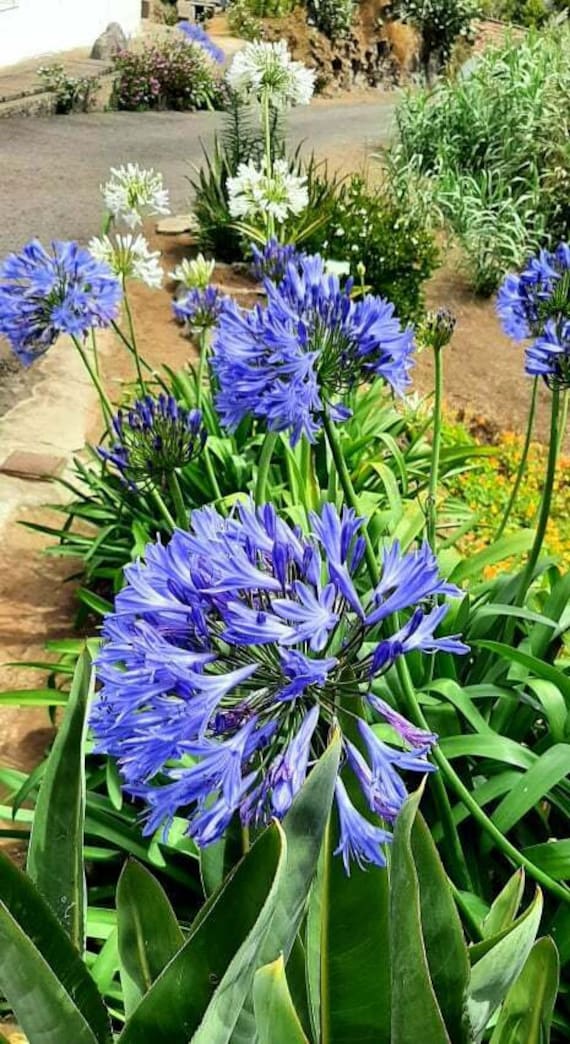Agapanthus Buddy Plant Kingdoms: Perfect Pairings for Your Garden
Agapanthus Buddy Plant Kingdoms: Perfect Pairings for Your Garden
Blog Article
Understanding the Art of Agapanthus Treatment: Important Actions for Healthy And Balanced Development and Vivid Blooms
In the realm of cultivation, the farming of agapanthus stands as a satisfying venture for those who look for to support these elegant blooming plants. From choosing the right selection to understanding pruning techniques, the trip in the direction of cultivating prospering agapanthus plants is multifaceted and holds the vital to opening the full possibility of these organic gems.

Selecting the Right Agapanthus Range

When selecting the appropriate Agapanthus variety for your yard, take into consideration aspects such as climate suitability, flower shade, and development routine. Additionally, think about the climate in your region to make sure the Agapanthus selection you select can grow in your details conditions. Recognizing the growth habit of different Agapanthus varieties is important for appropriate placement within your yard.
Suitable Planting Conditions
Considering the ideal environmental requirements is vital for effective Agapanthus growing. Agapanthus flourishes in well-draining soil with a somewhat acidic to neutral pH level. When growing, choose a location that receives complete sunlight to partial color. In hotter environments, providing some afternoon color can protect against scorching of the fallen leaves. Agapanthus plants are delicate to chilly temperature levels and should be shielded from frost during winter season.
To ensure healthy development and dynamic blooms, plant Agapanthus light bulbs at a deepness of about 2-4 inches and space them 8-12 inches apart. Including organic matter, such as garden compost, to the soil can enhance drainage and fertility, promoting durable root advancement. Mulching around the base of the plants helps maintain dampness and subdues weed development. Routine watering is vital, specifically during the expanding season, to keep the soil regularly wet however not soaked.
Watering and Feeding Tips
Preserving proper dampness levels and providing crucial nutrients are crucial elements in the treatment regimen for Agapanthus plants. It is critical to strike an equilibrium when it comes to sprinkling Agapanthus. If overwatered, these plants like consistently damp dirt however are prone to root rot. Throughout the growing period, water deeply when a week, ensuring the soil is well-draining to prevent waterlogging. In hotter climates or during durations of drought, more frequent watering may be required to keep the soil equally damp. Nonetheless, minimize watering in the winter months to protect against water logged conditions.
Feeding Agapanthus is essential for advertising healthy growth and respected blossoms. Apply a balanced plant food, such as a 10-10-10 formula, in the very early springtime as new development arises. Repeat this application every 6-8 weeks throughout the expanding season. Prevent too much fertilizing, as it can result in lavish foliage at the cost of flowers. Always follow the maker's directions for proper dilution and application techniques. By following these watering and fertilizing ideas, you can guarantee your Agapanthus plants thrive click for info and generate vivid, durable blooms.
Trimming Strategies for Agapanthus
Trimming Agapanthus plants at the appropriate times and with correct methods is vital for keeping their health and wellness and advertising optimal growth and flowering. The optimal time to prune Agapanthus is in late winter or very early springtime prior to brand-new growth emerges.
For flowered stems, wait up until the flowers have perished and afterwards cut them back to the base. This not only tidies up the plant's look however likewise urges the development of brand-new visit this site flower buds. Deadheading spent blossoms can additionally reroute the plant's energy into producing more blooms instead of setting seeds. Nevertheless, if you intend to accumulate seeds for propagation, leave some blossoms to fully grown and completely dry on the plant.
Bear in mind to use clean, sharp tools to make accurate cuts and minimize the risk of introducing illness. Agapanthus. Routine trimming will assist keep your Agapanthus looking healthy and neat while ensuring a plentiful screen of lovely flowers
Managing Typical Parasites and Illness
After making sure correct trimming strategies for Agapanthus, it is vital to address common pests and conditions that can affect the health and wellness and vitality of these plants. One usual pest that impacts Agapanthus is the Agapanthus gall midge.
Another usual concern is fungal fallen leave area, which provides as dark lesions on the leaves. To protect against fungal conditions, make sure great air circulation around the plants, stay clear of overhanging watering, and eliminate any type of infected fallen leaves promptly. In addition, Agapanthus plants can experience origin rot if they are planted in poorly draining pipes dirt. To stop this, plant Agapanthus in well-draining soil and prevent overwatering. By being watchful and taking punctual activity versus diseases and insects, you can help your Agapanthus plants thrive and generate lively blossoms.

Conclusion
To conclude, understanding the art of agapanthus care includes selecting the ideal variety, supplying perfect growing problems, proper watering and feeding, appropriate trimming strategies, and addressing typical pests and conditions. By complying with these important actions, you can ensure healthy development and lively blooms for your agapanthus plants. Keep in mind to routinely keep track of and maintain your plants to advertise their total health and long life.
To make sure healthy growth and vivid flowers, plant Agapanthus light bulbs at a depth of about 2-4 inches and room them 8-12 inches apart. By adhering to these watering and fertilizing tips, you can guarantee your Agapanthus plants prosper visit their website and create vibrant, durable blossoms.
One usual pest that affects Agapanthus is the Agapanthus gall midget. Additionally, Agapanthus plants can suffer from origin rot if they are planted in badly draining soil. By complying with these vital steps, you can guarantee healthy development and vivid blooms for your agapanthus plants.
Report this page